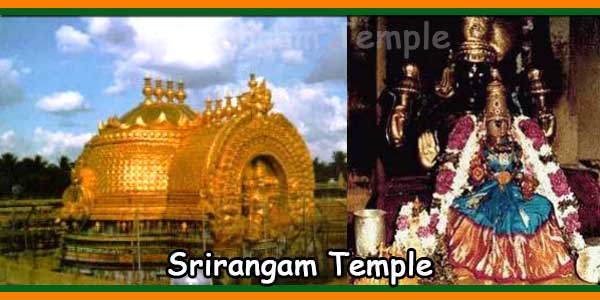Srirangam, the premier Vaishnava temple in South India is the first and foremost among the 108 Divya desams. All the Azhwars have sung in praise of the deity enshrined in this temple. In the Vaishnava parlance, the term “Koyil” signifies the Srirangam temple only. Located near Tiruchirappalli, on an island formed by the rivers Cauveri and Kolledam, stands the massive temple of Srirangam.
It has a main shrine for Lord Ranganatha, also called Nam Perumal, in a reclining posture on Adisesha. The Thayar is Ranganayaki with a shrine in the fourth prakaram. The Theertham is Chandra pushkarini and the Vimanam Pranavaakriti Vimanam. There are also shrines for Rama, Krishna, Nachiyar, Chakratalvar, Garuda, Hanuman, and Andal. In Srirangam there is the Dasavathara temple, the only one of its kind enshrining all the ten incarnations of Lord Vishnu.
According to the Sriranga Mahathmyam the glittering Sriranga Vimana sprang as a result of the tapas of Brahma in the depths of the Milky Ocean. It was borne by the celestial bird Garuda. Adisesha had spread his hood over it.
Brahma found Lord Vishnu resting on Adisesha, and was informed that He had come as Swayamvyakta – on his own as an idol. He would also appear likewise in seven other places on earth — Srimushnam, Venkatadri, Saligram, Naimisaranya, Thotadri, Pushkar and Badri. Ranga Vimana is the first and the earliest of all these. Brahma carried the Vimana to Satyaloka and installed it on the banks of the river, Viraja. He appointed the Sun God to perform the daily worship. Responding to the prayers of the King of Ayodhya of Iswaku race (Surya Vamsam) Brahma permitted him to take the Vimanam to Ayodhya.

Thus, the Vimanam came to Ayodhya. After Ikshvaku, his descendants continued the service of worshipping the Lord. . Rama, himself an avatara of the Lord in the Ishwaku race, worshipped Ranganatha and thereafter Lord Ranganatha came to be known as “Periya Perumal”. On his triumphant return from Sri Lanka and during his coronation, Rama gave the Vimana as a gift to Sri Vibheeshana for worship.
When Vibheeshana set out for Sri Lanka, He got down on the Kaveri banks to perform his mid-day prayers. He placed the Ranga Vimana at a place known as “Sesha Peetam” (Srirangam) near the Chandrapuskarani. Later when he tried to lift the Vimana, it would not move as it got stuck. When Vibheeshana was overcome with grief, the Lord appeared before him and consoled him saying that He had already decided to make this place His abode and Vibheeshana could come and worship him daily. It is said that even today Vibheeshana worships the Lord daily at midnight.
All the Azhwars except Madhura kavi Azhwar have composed pasurams in praise of the Lord in this kshetram. Vedanta Desika composed Paduka Sahasram (1008 slokas) in different metres.
Azhwar Mangalaasaasanam:
Periyaazhwar – 183, 189, 212, 245, 402-432
Aandal – 607-616
Kulasekhara Azhwar – 647-676, 728
Tirumazhisai Azhwar – 772, 800-806, 844, 870, 2384, 2411, 2417, 2441
Tondaradipodi Azhwar – 872-926
Tiruppan Azhwar – 927-936
Tirumangai Azhwar – 1019, 1213, 1378-1427, 1506, 1571, 1664, 1829, 1978, 2029,
2038, 2043, 2044, 2050, 2062, 2063, 2065, 2069, 2070, 2073-76, 2673 (71), 2674 (118)
Poygai Azhwar – 2087
Bhootathaazhwar – 2209, 2227, 2251, 2269
Peyaazhwar – 2342, 2343
Nammaazhwar – 2505, 3348-3358 (pasuram numbers as found in Naalaayira Divya prabhandam)
It is significant that Ramanuja completely overhauled the administrative system in this temple and saw to it that great care was exercised in the matter of control of the temple affairs.
The physical body of Ramanuja, who lived for nearly 120 years, is still being preserved in a sitting posture in the sannidhi dedicated to him on the southwest corner on the fifth prakaram of the temple. Shrines for all the Azhwars and Acharyas are also found within the temple precincts.
Arayar Sevai one of the ancient arts of rendering and expressing Naalaayira Divya prabhandam, in a dance form originated at this kshetram under the auspices of Nadamuni. Arayar Sevai is also performed at Srivalliputtur, Azhwar Tirunagari, Tirukkurungudi, and Melkot.
This temple is enormous in size and is the largest temple complex with 156 acres in extent, surrounded by seven concentric walls (the outermost wall having a perimeter of over 3 kilometers) and 21 gopurams. It has seven Prakarams or Tiru Veedhis running around the sanctum. The total length of these seven walls is 32,592 feet, approximately around 9 Kms. There are magnificent towers in all Prakaras and the latest addition is the 236 feet high thirteen tiered Rajagopuram built at the southern rampart by the late 44th Jeeyar of Sri Ahobila Mutt.
Pilgrims from all over India visit this shrine, and there are festivals all through the year.
Vaikunta Ekadasi during Margazhi and the Tirukalyana festival during Panguni attracts very large crowd.
